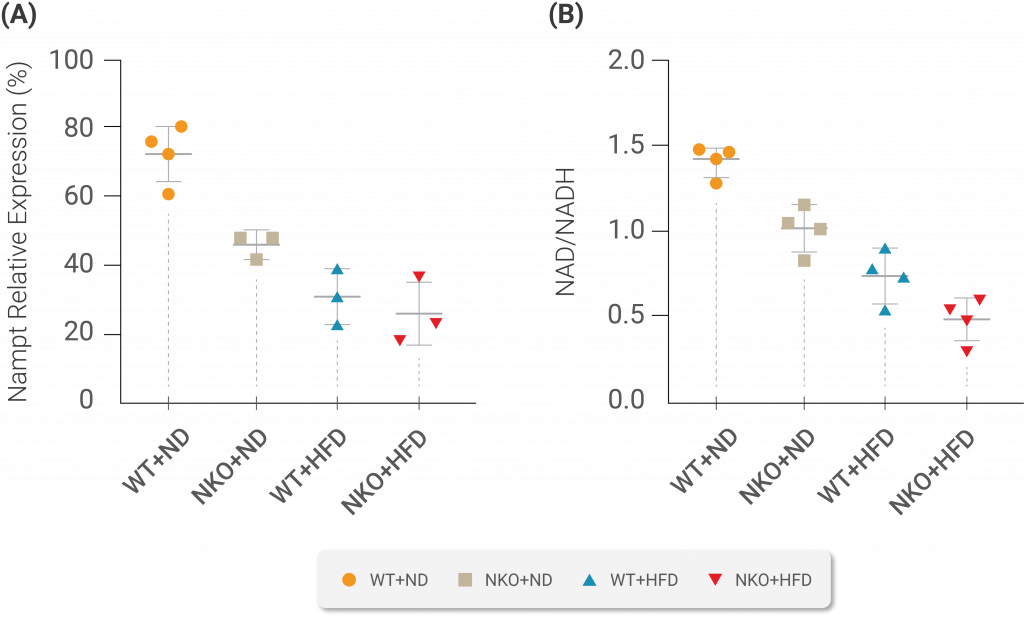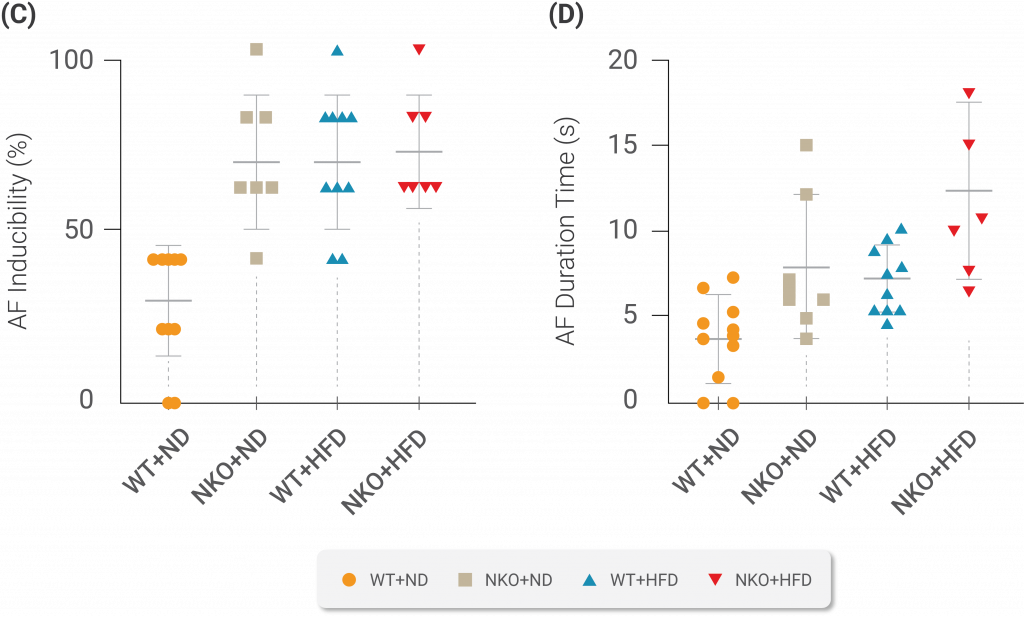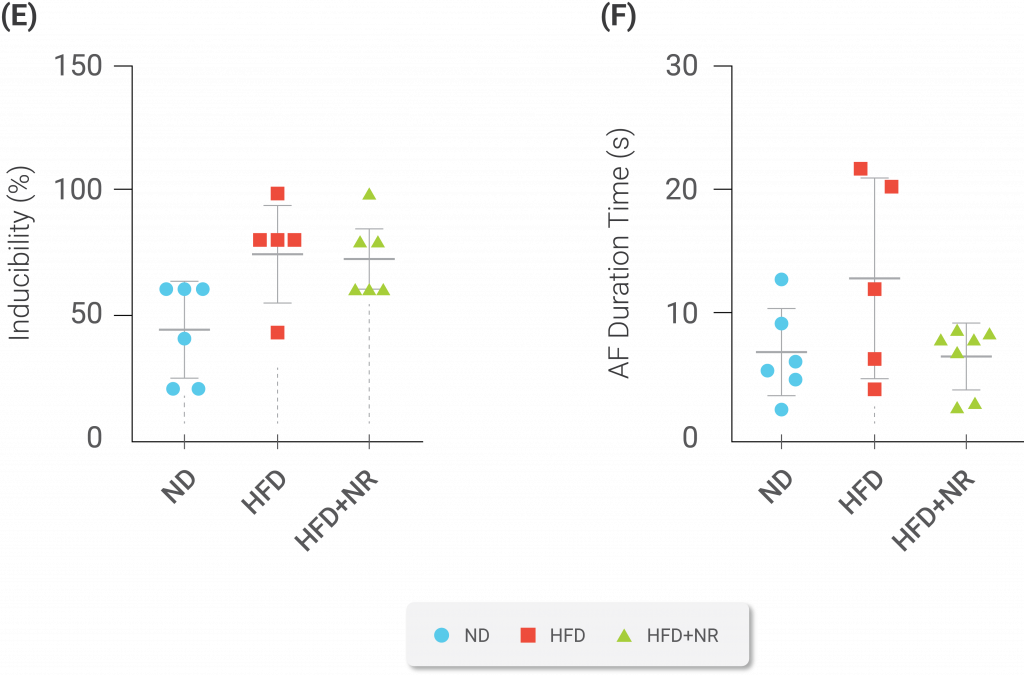Aging and obesity increase the risk of humans developing onset atrial fibrillation, a condition where the upper (atria) and lower (ventricles) chambers of the heart have unsynchronized beating rhythms. Atrial fibrillation is the most prevalent issue pertaining to the rate or rhythm of the heartbeat, and it is known to affect over 33 million people worldwide. One enzyme with high expression levels in heart cells is nicotinamide phosphoribosyltransferase (Nampt), a mediator of the essential coenzyme nicotinamide adenine dinucleotide involved in aging and metabolism. While recent studies have shown that Nampt is malfunctional in various heart conditions, scientists have yet to elucidate the connection between atrial fibrillation and Nampt.
In an article published in the International Journal of Molecular Sciences, a team of investigators from the University of Tsukuba in Japan modeled obesity utilizing mice fed high fat diets, and results showed diminished levels of Nampt. In addition, mice became more susceptible to atrial fibrillation, and those with atrial fibrillation exhibited longer durations of the condition. However, upon supplementation with nicotinamide riboside (NR), known to restore NAD+ levels, the mice fed high fat diets showed partial restoration of atrial fibrillation perpetuation. Thus, the obtained results indicate that the Nampt/NAD+ axis may serve as an effective therapeutic target for atrial fibrillation.
All cells in your body contain NAD+ and Nampt, and evidence shows that aging and obesity induce diminished levels of these vital compounds. In addition, the Nampt/NAD+ axis has been proven to protect against aging and obesity-related conditions, such as type 2 diabetes. Due to obesity and aging, two of the most prominent risk factors for atrial fibrillation, promoting decreased levels of Nampt and NAD+, the team of researchers evaluated whether the Nampt/NAD+ axis contributed to onset atrial fibrillation caused by obesity. To assess this, investigators attempted to determine how the interaction between the Nampt/NAD+ axis and diet affects atrial fibrillation in mice.
In the study, the investigators discovered that mice fed high fat diets exhibited half the levels of Nampt in their atrial tissues compared to mice fed regular diets. After genetically altered mice with reduced Nampt were fed high fat diets, their atrial tissues had significantly lower amounts of Nampt than mice fed conventional diets. In addition, investigators noticed considerably diminished NAD+ levels in the atria of mice fed high fat diets when they were either genetically unmodified or genetically altered to have lower Nampt compared to mice fed regular diets. Collectively, the obtained results suggest that diet induces changes in the Nampt/NAD+ axis in the atria of mice.

Mice fed high fat diets have reduced Nampt levels in atrial tissues. (A) Nampt levels were reduced by nearly 50% in mice fed high fat diets and genetically modified mice fed normal diets compared with mice fed normal diets, and were further decreased in genetically modified mice fed high fat diets. (B) There were significant decreases of NAD+/NADH ratio in the other three groups compared to the mice fed normal diets. Wt+ND, mice fed normal diets; NKO+ND, genetically modified mice with decreased Nampt fed normal diets; Wt+HFD, mice fed high fat diets; NKO+HFD, genetically modified mice with decreased Nampt fed high fat diets.
Mice fed high fat diets and genetically altered mice with diminished levels of Nampt exhibited greater vulnerability to atrial fibrillation and prolonged duration of the condition without severe structural cardiac irregularities. Furthermore, investigators demonstrated that genetically altered mice with lower Nampt who were also fed high fat diets showed even longer prolonged duration of atrial fibrillation.

Genetically modified mice with decreased Nampt and mice fed high fat diets have increased atrial fibrillation susceptibility and duration. (C) AF susceptibility was significantly increased in mice fed high fat diets, genetically modified mice fed normal diets, and genetically modified mice fed high fat diets compared with mice fed normal diets. (D) Atrial fibrillation duration was significantly longer in mice fed high fat diets and genetically modified mice fed normal diets and further prolonged in genetically modified mice fed high fat diets compared with mice fed normal diets. Wt+ND, mice fed normal diets; NKO+ND, genetically modified mice with decreased Nampt fed normal diets; Wt+HFD, mice fed high fat diets; NKO+HFD, genetically modified mice with decreased Nampt fed high fat diets.
The team of researchers evaluated whether the NAD+ precursor NR could prevent arrhythmias, issues regarding the rate or rhythm of the heartbeat, caused by a high diet by comparing mice treated with the following three diets: normal diets, high fat diets, and NR supplemented high fat diets. After NR supplementation in mice fed high fat diets, investigators found that the diminished Nampt levels were restored. In addition, NR supplementation induced restoration of NAD+ levels. Despite no significant changes in atrial fibrillation susceptibility, the electrophysiological study found that NR supplementation reduces atrial fibrillation duration time to that observed with a regular diet.

NAD+ precursor NR increases Nampt amount and decreases atrial fibrillation duration. Treatment with NR restored atrial fibrillation susceptibility and duration in mice fed high fat diets. ND, mice fed normal diets; HFD, mice fed high fat diets; HFD+NR, mice fed high fat diets supplemented with NR.
“Our data showed that NR supplementation significantly increased Nampt and NAD levels in high fat diet fed mice,” said the investigators in their study. “Also, atrial fibrillation duration… significantly recovered by NR supplementation. Taking our data and previous findings together, NR may be a promising therapeutic agent for cardiovascular diseases, including atrial fibrillation, in clinical practice.”